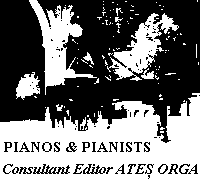 |
PIANOLA TO REPRODUCING PIANO: 4
A Plaine and Easie Introduction
|
The Market Place
Endorsement has always been a good sales pitch. Just as the conventional
piano makers vied for the best players, so, too, did the reproducing piano
hierarchy. They wooed and won over the critics (not least Ernest Newman,
who went so far as to publish a book, The Piano Player and its Music, in
London in 1920). They sponsored spectacular concerts with their reproducing
rolls playing to thousands, accompanied by the world's great orchestras
and conductors. Metrostyle's early 'Autograph Interpretations'
(c 1906) - rolls annotated for performance by artists or composers - included
an impressive line-up of personalities. Composers like Albeniz, Balakirev,
Debussy, Faure, Glazunov, Grieg, Moszkowski, Rimsky-Korsakov and Widor.
And pianists like Busoni (on Liszt), Landowska (on Bach, Chopin, Clementi
and Haydn), and Paderewski (on Chopin and Mozart).
Exclusivity was critical. Welte had Bartok, Debussy, Faure, Glazunov,
Leschetizky, Mahler, Ravel and Respighi under contract. Duo-Art boasted
Arrau, Gershwin, Myra Hess, Horowitz, Paderewski, Artur Rubinstein, Prokofiev
and Stravinsky. Ampico signed-up Levitzki, Moisewitsch, Rachmaninov
and Rosenthal. Hupfeld of Lepizig, too, could claim a notably pedigree
stable: d'Albert, Backhaus, Busoni, Gieseking, Grieg, Landowska, Mascagni,
Saint-Saens, Scriabin, Scharwenka. Not all that has survived (many rolls
have disappeared or disintegrated) is reliable as a guide to how these giants
of history played: there can be too many reproduction variables and inponderables.
But those factors which regardless are constant or relative (re-texturings,
tempo/proportional rhythm changes, ornamentation, cadenzas, cuts or re-workings,
interpolations) offer frequently unique insight into crannies of late-Romantic
performing practice yet to be properly documented.
Rise and Fall
'A hopeless snarl of patents, mergers, lawsuits and thivery'
is how William Brooks has described the early history of the American self-playing
piano. Leading up to the Second World War, its effective lifespan, pneumatically-speaking,
was just forty years. In that time it went from a simple means of entertainment
and patriotism ('The "Pianola" Piano enables you to play the National
Anthem of the Allied Nations as well as all the marching tunes to our "Tommies" ',
1915) to a tool of learning. A reproducer of the legendary classical, ragtime
and jazz greats from the cusp of two centuries, it died dispensing muzak
or having its innards ripped out.
The rise and fall of the medium (under many brand names) can be judged
from US sales: 34,495 upright player pianos in 1909 > 170, 549 in 1923
> c 250 in 1937. Of the 305,000 pianos made in America in 1925, 169,000
(55.4%) were automatics. From 1925 to 1931 (through the period of the Wall
Street Crash and a massive growth of interest in the wireless), piano sales
in America plummeted from $94m annually to $12m. Before the Depression,
foot-pumped pianolas were cheap. Electric reproducers, though, were many
times more expensive. 'In an era when sales of common foot-pumped players
were counted in the millions, reproducing pianos were sold by the thousands'
(David L Saul). A post-war 1929 Harrods catalogue shows quality Broadwood-Ampico
mahogany uprights selling for over 300 guineas, with desirable 6'3"
Bluthner-Hupfeld rosewood grands with aliquot scaling in excess of 500.
Other showrooms were cheaper, but the investment was still considerable
- and clearly elitist.
Within a decade the pneumatic reproducers, 'the Rolls-Royces of the player-piano
world' as Arthur W.J.G. Ord-Hume calls them, were to be no more.
Phoenix Ascendant
Modern technology - electronic rather than pneumatic - has witnessed
a significant late 20th century resurgence of interest in the acoustic piano
as a reproducing instrument. At under $2,000 and fittable to any piano,
the computerised Californian Superscope-Marantz Pianocorder (1978)
replaced rolls with digitally encoded cassettes (using material from
the Welte, Duo-Art and Ampico catalogues), the output of which was fed to
keyboard solenoids. Like the old pneumatic systems, the pianocorder had
separate bass and treble 'expression'.
Today's Japanese reproducing pianos (Yamaha founded 1887, Kawai
founded 1925) work on a compact disc principle, with library performances
activating keyboard and pedal actions. Bösendorfer (founded
Vienna 1828) also use a disc system. But their flagship reproducing design
is the extraordinary computerised Model 290 SE with MIDI/IBM
interface (1986). Fitted into an eight-octave Imperial Grand, this is an
expensive item: £110,000 against around £70,000 for a standard,
unconverted instrument. And exclusive: by 1996 only twenty-eight had been
made, mostly for America or the exhibition circuit. Developed by Wayne Stahnke,
an American aerospace engineer, it's claimed by Bösendorfer (echoing familiar
old-fashioned copy-writer's jargon) to be 'the world's finest high-performance
reproducing system in the world's finest piano', 'the ultimate teaching
instrument for the artist, the teacher and the student of music'. With a
library of pre-recorded music, the 290 SE is also a digital recording medium
(unaffected by incidental, exterior noise) with complex editing, transposition
and vari-speed facilities. It has automatic action calibration. It repeats
at 16 notes a second (twice that of the finest pneumatic systems, and better
than the best pianists). It measures pedal accuracy to 1,000th of an inch.
And its 1,000 degrees of dynamic intensity compare dramatically with the
pianocorder's 32, Duo-Art's 16, or the mere seven believed by one early
writer to have been sufficient for the human ear (Journal of Applied
Psychology, 1928).
'To use electrical power in the service of intelligence fills me with
admiration' - Grieg.
© Ates Orga February 26th 1999
|